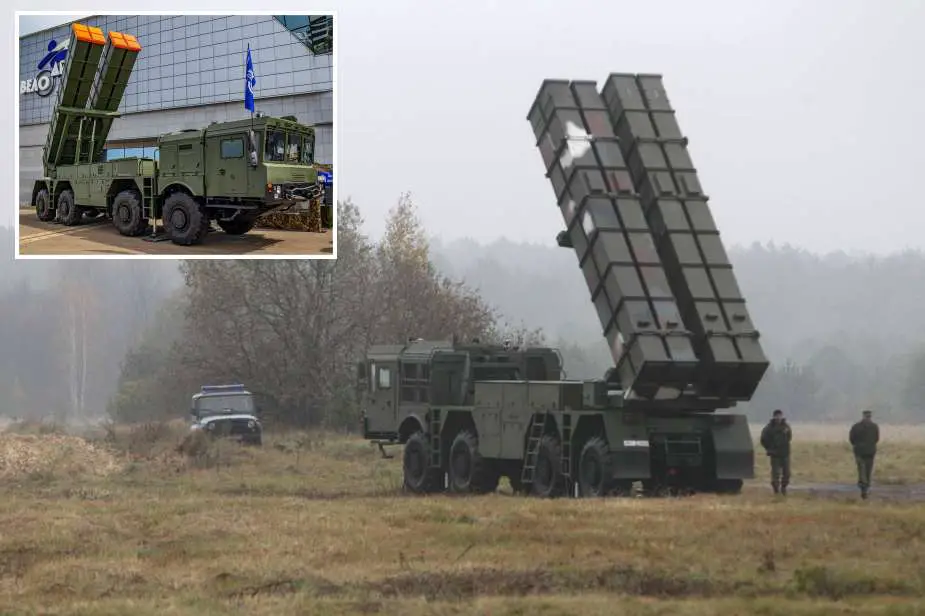Breaking news
Belarus conducts exercises with Polonez MLRS near Poland and Lithuania borders.
According to an article from Sputnik on August 8, 2023, the Belarusian military is currently conducting a field exercise with the aim of improving their operational coordination between the V-200 Polonez multiple rocket launcher systems (MLRS) and unmanned aerial systems. The current exercise takes place in the Grodno region of Belarus, near the so-called Suwalki Gap, amidst ongoing geopolitical tensions involving Poland, Belarus, and Russia.
Follow Army Recognition on Google News at this link

Belarus conducts exercises with Polonez MLRS near Poland and Lithuania borders (Picture source Yandex)
During the exercise, members of the 231st Artillery Brigade are actively participating in familiarizing themselves with the V-200 Polonez MLRS, which is planned to be integrated into the brigade's armament in the near future. Training with the BM-27 Uragan MLRS is also included in the curriculum, but the primary focus is on the effective integration of the V-200 Polonez system.
Throughout the exercise, participants are concentrating on gaining insights into the technical and tactical aspects of the V-200 Polonez rocket launcher system. This includes training on control mechanisms, target acquisition procedures, and firing protocols. The missile operators are engaged in complex exercises involving coordinated missile strikes to assess the coordination between the V-200 Polonez rocket launchers and unmanned systems, specifically the Supercam-S350 and Supercam-S100.
Amidst ongoing geopolitical tensions in Eastern Europe involving Poland, Belarus, and Russia, the current exercise gains context, as it takes place in the Grodno region of Belarus, near the so-called Suwalki Gap. Poland's recent decision to deploy a sapper battalion, armed with Baobab-K minelaying vehicles, near its border with Belarus reflects concerns about regional security. The Suwalki Gap, a region of strategic importance between Poland and Lithuania, has drawn attention due to its potential significance for NATO's defense strategy. There are concerns that this gap could be exploited by Russia to disrupt access to the Baltic States, leading to an increased focus on NATO's security considerations.
Another factor contributing to the complex landscape is the presence of Wagner mercenary fighters, allegedly backed by Russia, within Belarus. President Vladimir Putin's warning against aggression towards Belarus further escalated tensions. These developments have drawn attention to the security of the Suwalki Gap, prompting Poland to reinforce its defensive measures in the region. In the midst of these geopolitical dynamics, the ongoing exercise and Poland's sapper battalion deployment are practical responses, illustrating strategic efforts to navigate the evolving situation in Eastern Europe.
As diplomatic and military maneuvers continue between Poland, Belarus, and Russia, uncertainties persist. The sapper battalion deployment serves as a manifestation of Poland's cautious approach to regional security matters, while the exercise represents a tangible aspect of their efforts to address complex geopolitical challenges. In this intricate landscape, these actions reflect Poland's ongoing commitment to maintaining stability and managing the evolving geopolitical dynamics in Eastern Europe.
The V-200 Polonez, also known as Polyanez, is a Belarusian MLRS capable of launching various types of rockets, including guided and unguided missiles. These rockets can carry different types of warheads, such as high-explosive, fragmentation, or even precision-guided munitions. Even at its maximum range of 200 km, the system maintains accuracy within a 30-meter deviation. Designed by Igor Dantsov and Yuri Cherny, the system was developed by the "Plant of Precise Electromechanics" in Belarus and was unveiled on May 9, 2015, during a military parade in Minsk.
Furthermore, the system has undergone modernization efforts, resulting in an upgraded variant, the Polonez-M. This upgraded version features an extended firing range of 299 km, representing a 50% increase and highlighting ongoing efforts to enhance the system's capabilities.


























